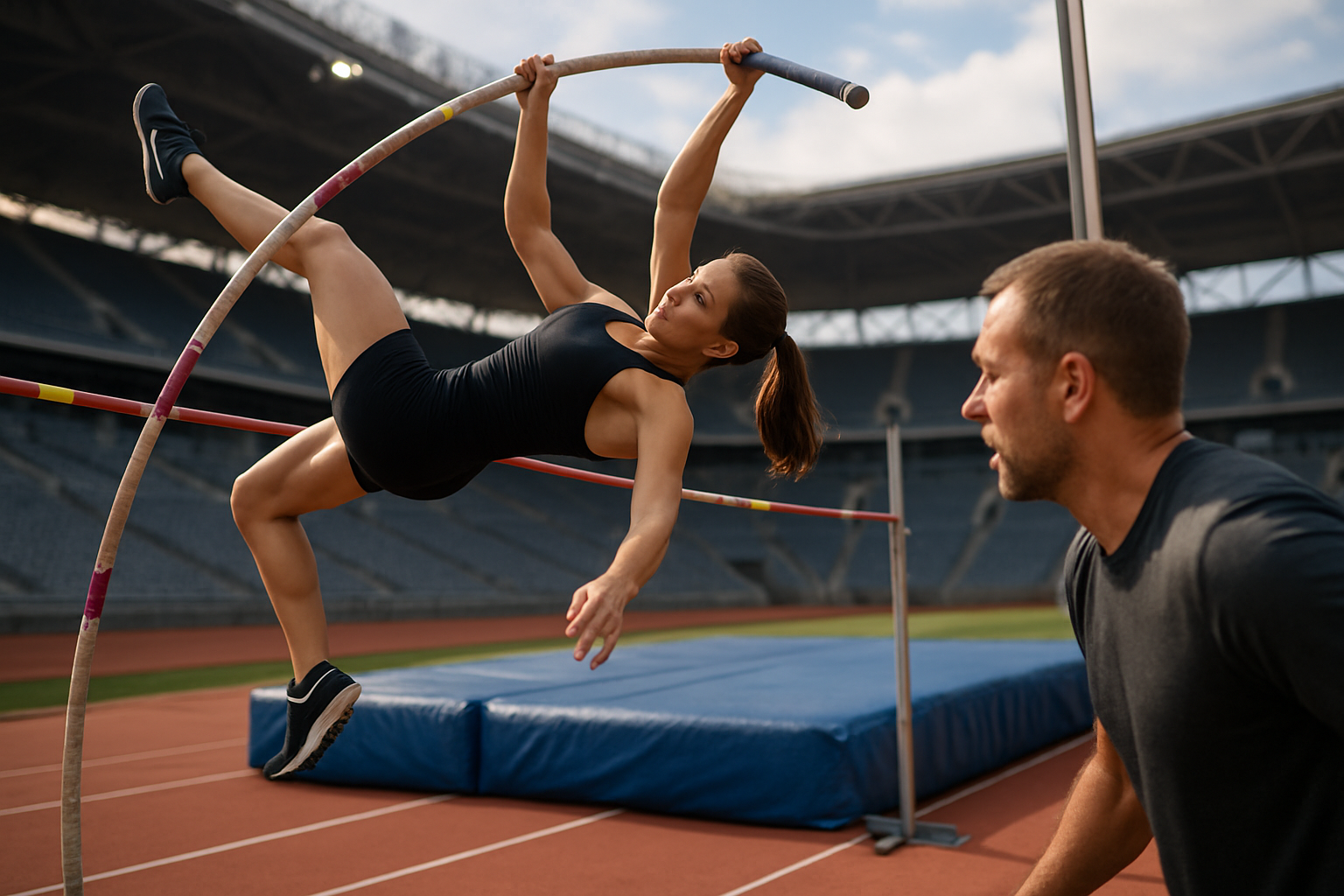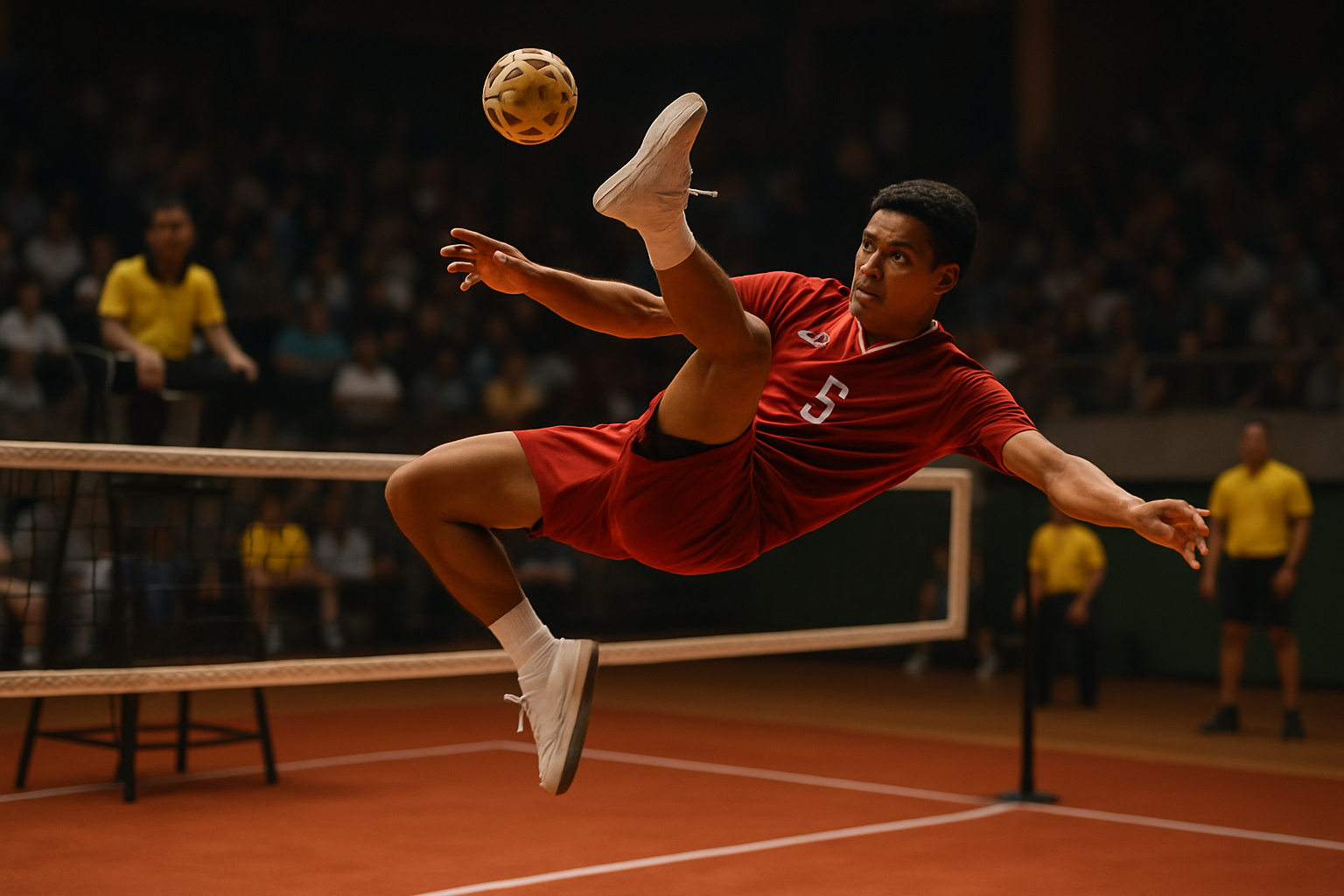Biomechanics of Pole Vaulting: The Science Behind Defying Gravity
Picture an athlete sprinting down a runway, planting a flexible pole, and soaring over a bar set at impossible heights. Pole vaulting is a captivating blend of speed, strength, and technique that pushes the boundaries of human physical capability. This article delves into the intricate biomechanics behind this awe-inspiring track and field event, exploring how athletes harness physics to achieve seemingly superhuman feats.

Today’s elite pole vaulters employ a highly refined technique that maximizes energy transfer and minimizes energy loss throughout the vault. The approach run, pole plant, takeoff, swing up, extension, and bar clearance are all meticulously choreographed movements that work in harmony to propel the athlete skyward.
The Approach: Building Kinetic Energy
The vault begins with the approach run, a critical phase where the athlete generates the kinetic energy needed to power the entire movement. Vaulters typically cover a distance of 30 to 40 meters, gradually accelerating to reach their maximum controllable speed just before planting the pole.
During this phase, biomechanical efficiency is paramount. Athletes maintain an upright posture with a slight forward lean, allowing for optimal force production through the ground. The arms pump in sync with leg movements, creating a rhythmic cadence that helps maintain balance and momentum.
Research has shown that approach velocities for elite male vaulters can reach up to 9.5 meters per second, while female vaulters achieve speeds around 8.5 meters per second. This translates to a massive amount of kinetic energy that will be converted into potential energy as the vaulter ascends.
The Plant and Takeoff: A Crucial Energy Transfer
As the vaulter reaches the end of the approach, they enter the most technically demanding phase of the vault: the plant and takeoff. This moment requires precise timing and coordination to effectively transfer the horizontal momentum into vertical lift.
The plant begins as the vaulter lowers the pole tip into the box, a metal-lined trough at the base of the standards. Simultaneously, the takeoff foot strikes the ground, initiating a powerful extension of the leg to drive the body upward. The non-takeoff leg swings forward and up, contributing to the overall lift.
Biomechanically, this phase involves a rapid deceleration of the center of mass as the pole begins to bend. The vaulter’s body experiences forces up to 4-5 times their body weight during this brief moment. The flexibility of modern poles allows them to store a significant portion of the kinetic energy as elastic potential energy, much like a spring being compressed.
The Swing and Extension: Maximizing Vertical Displacement
As the pole bends and begins to recoil, the vaulter enters the swing phase. This is where the athlete’s gymnastic abilities come into play. The goal is to rotate the body from a nearly horizontal position at takeoff to a vertical, upside-down position at the peak of the vault.
The swing is initiated by the powerful hip flexion of the lead leg, followed by a coordinated movement of the arms and torso. As the pole straightens, the vaulter extends their body, pushing off the pole with their bottom hand to maximize vertical displacement.
Biomechanical studies have revealed that successful vaulters achieve a high degree of synchronization between their body movements and the recoil of the pole. This timing is crucial for efficient energy transfer and can make the difference between clearing the bar and knocking it off.
Bar Clearance: The Final Challenge
The final phase of the vault is the bar clearance, where all the preceding biomechanical elements culminate in a split-second maneuver to pass over the crossbar. As the vaulter reaches peak height, they must quickly rotate their body to a horizontal position, arching their back to allow their hips to clear the bar.
This movement, known as the “layout,” requires exceptional body awareness and control. The vaulter must time their rotation perfectly to avoid making contact with the bar while still at the apex of their trajectory.
Interestingly, biomechanical analysis has shown that elite vaulters often clear heights significantly above their center of mass at peak vault. This is achieved through the strategic positioning of body segments during the clearance phase, effectively “wrapping” the body around the bar.
The Role of Equipment in Biomechanical Optimization
While the athlete’s technique is paramount, the equipment used in pole vaulting plays a crucial role in biomechanical optimization. Modern poles are precisely engineered to match the vaulter’s weight, speed, and grip height, allowing for maximum energy storage and release.
The pole’s flex rating, or stiffness, is carefully selected to ensure it bends sufficiently under the vaulter’s weight and speed without breaking. A pole that’s too stiff will not bend enough to store adequate energy, while one that’s too flexible may bend too much, dissipating energy and reducing the vault’s height.
Additionally, the composition and design of the pole affect its recoil characteristics. Carbon fiber poles, for instance, offer a quicker recoil than traditional fiberglass poles, potentially providing a slight edge in energy return.
Biomechanical Differences Between Male and Female Vaulters
While the fundamental biomechanics of pole vaulting remain the same regardless of gender, there are some notable differences in technique and performance between male and female vaulters. These differences primarily stem from variations in strength, speed, and anthropometric characteristics.
Male vaulters generally achieve higher vault heights due to their ability to generate greater approach speeds and handle stiffer poles. This allows them to store and release more energy during the vault. The world record for men stands at 6.21 meters, while the women’s record is 5.06 meters.
However, biomechanical studies have shown that female vaulters often demonstrate superior efficiency in energy transfer during the swing and extension phases. This is attributed to their typically lower center of mass and greater flexibility, allowing for a more fluid rotation around the pole.
Injury Prevention Through Biomechanical Understanding
The extreme forces and complex movements involved in pole vaulting make it a sport with a significant risk of injury. Understanding the biomechanics of vaulting is crucial not only for performance enhancement but also for injury prevention.
Common injuries in pole vaulting include shoulder dislocations, wrist sprains, and lower back strains. Many of these injuries occur due to improper technique or mismatched equipment. For example, using a pole that’s too stiff can lead to excessive stress on the shoulder during the plant phase.
Biomechanical analysis has led to the development of safer vaulting techniques and equipment. For instance, the importance of maintaining a straight arm during the plant and takeoff has been emphasized to reduce the risk of shoulder injuries. Similarly, landing mats have been redesigned based on impact force studies to better absorb the energy of a falling vaulter.
Training Implications of Pole Vault Biomechanics
Understanding the biomechanics of pole vaulting has profound implications for training methodologies. Coaches and athletes now focus on developing specific strength and power attributes that directly correlate with improved vaulting performance.
For example, plyometric exercises that enhance explosive leg power are crucial for generating the force needed during takeoff. Core strength training is emphasized to improve body control during the swing and extension phases. Gymnastic-style exercises are incorporated to develop the body awareness and rotational skills necessary for efficient bar clearance.
Moreover, biomechanical analysis tools, such as high-speed video cameras and force plates, are increasingly used in training to provide immediate feedback on technique. This allows for rapid adjustments and more efficient skill acquisition.
The Future of Pole Vault Biomechanics
As our understanding of human biomechanics and materials science continues to advance, the future of pole vaulting promises even more extraordinary performances. Researchers are exploring new pole materials and designs that could further optimize energy storage and release.
Additionally, the integration of wearable technology and AI-driven analysis is opening up new possibilities for real-time biomechanical feedback during training and competition. This could lead to more personalized technique refinements and push the boundaries of human performance even further.
Some biomechanists speculate that future innovations might include poles with variable stiffness along their length, allowing for more precise energy management throughout the vault. Others are investigating the potential of biofeedback systems that could help vaulters achieve optimal muscle activation patterns during each phase of the vault.
Conclusion: The Artistry of Applied Physics
Pole vaulting stands as a testament to the remarkable capabilities of the human body when guided by scientific understanding. The biomechanics of this sport reveal a delicate interplay between muscular power, elastic energy, and rotational dynamics, all choreographed in a fraction of a second.
As we continue to unravel the complexities of pole vault biomechanics, we not only push the limits of athletic performance but also gain valuable insights into human movement that can be applied across various fields, from sports medicine to robotics.
The pole vault serves as a beautiful example of applied physics, where success is measured in centimeters but achieved through a deep understanding of forces, energy transfer, and human physiology. It reminds us that in the world of sports, as in science, the pursuit of excellence is an ongoing journey of discovery and refinement.





